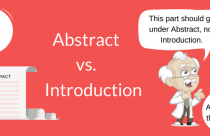Writing the Title Page (Part 2)

In our last post, we discussed the elements that are always included in the title page regardless of the journal chosen for publication (i.e., Article title, Author names, Author affiliations, Corresponding author information). In this post, we discuss in detail the elements whose inclusion is subject to the journal guidelines.
Headers
The journal guidelines specify the information that needs to be included in the header. Usually, it is just the running title of the article, or running title along with the first author name.
-
Running title
Running titles are short phrases or shorter versions of the main title that appear at the top or bottom of every page in a journal article.
Example
Main title: “Improvement of deficient natural killer activity and delayed bactericidal activity by a thiol proteinase inhibitor, human cystatin C, in leukocytes from patients with Griscelli’s syndrome”
Running Head: Effect of cystatin C on NK and bactericidal activity
-
Running Title with First Author Name
Usually, the running title appears as a header along with the first author’s name and the page number.
Footnotes
These notes are either provided on the Title Page or after the Acknowledgements section depending upon the journal guidelines.
-
Grant Support
Any grants received by any of the authors for the study are acknowledged in the “Grant Support” section.
Include all organizational support in the grant support note, including fellowships, chairs, and grants.
Tip 1!
Any nonauthor individual contributions should not be included in this section. It can be listed in Acknowledgments.
Journals generally ask the authors to designate which author received which support by inserting parenthetical sets of initials.
For example
“Supported by grants from the ABC Foundation (grant no.) and the National Institutes of ABC (grants CA41456 and CA72009) (A.B.).”
-
Conflict of Interest
Declaration of all commercial interests should be listed in this section.
Journals usually specify the authors to include a statement such as
“This study involves no conflicts of interest”
Or in case of absence of any potential financial disclosures,
“The authors declare no conflicts of interest”
-
Authorship
The definition of an author varies with the field, culture, and even research group. Therefore, the rules to be used for determining authorship, including the order of authors, should be clearly agreed upon at the outset of a research project.
Authorship usually denotes an “intellectual contribution” to the work and that an author should be able to explain and defend the work.
Tip 2!
Listing someone who has not made an intellectual contribution (e.g., the head of the department or someone who provided the funds, “honorary authorship”) as an author would be considered unethical (such persons can be acknowledged in the acknowledgement section).
Independent of the method used to determine authorship, it is essential that all authors have given their consent to be designated as such and have approved the final version of the manuscript.
A statement declaring the same is usually provided by the authors in this section.
An authorship statement would include: designed research, performed research, contributed vital new reagents or analytical tools, analyzed data, and wrote the paper.
For example
“A.B. and C.D. participated in designing and performing the research; E.F. centralized the pathological review; D.E., G.H., and E.C. controlled and analyzed data; D.G. and G.F. wrote the paper; and all authors checked the final version of the manuscript.”
-
Statement of Author Death
In case of death of any of the contributing authors, a statement should be included on the title page.
The note should use the author’s full name as listed and should give the date of death.
For example
Joel A. John died on December 13, 1990.
If necessary, indication of the extent of that author’s contribution may be included.
For example
Joel A. John died on September 15, 1998, during the preparation of this manuscript.
Keywords
Most readers research for an article through keyword search; hence, finding the right keywords is essential to enable the readers to find this paper when searching a relevant database.
Tip 3!
The key to finding appropriate keywords is to avoid using generic terms or long phrases as keywords. Consider using two or three terms to best describe the essential subject(s) of your article.
For example
For an article titled “Effect of light spectrum on antioxidant activity of fern (Onoclea sensibilis),”Keywords can be “light spectrum” “antioxidant activity” “Onoclea sensibilis”
Instructions to Authors regarding keywords vary for different journals and the selected journal should be consulted before selecting keywords.
Nowadays, journals either provide a list of keywords for authors to select appropriate keywords suitable for their article or recommend using Online web applications for searching appropriate keywords (e.g., MeSH Browser, http://www.nlm.nih.gov/mesh/MBrowser.html).
List of Abbreviations
Journals usually prefer the nonstandard abbreviations used to be either defined at the first mention or to be listed on the title page as a footnote.
Ideally, it is recommended that nonstandard abbreviations be used sparingly to avoid making the list unnecessarily lengthy.
The abbreviations used for metric units need not be included in this section.
Miscellaneous Information
Other miscellaneous elements that are usually included on the title page are as follows:
- The type of article
e.g., Original article, Review, Case report, etc.
- Word count specified for the article type
e.g., Word count of Abstract, Text, Total number of pages, tables, figures, etc.
We hope these tips and pointers help you frame a better title page!










This article helped me to create the title page when preparing to submit my journal article.
Hi Fru Akuma,
Thank you for sharing your feedback. We are glad to have been helpful to you while drafting your journal article. You can also check through our resources on the other aspects of academic writing under the following link: https://www.enago.com/academy/category/academic-writing/ .